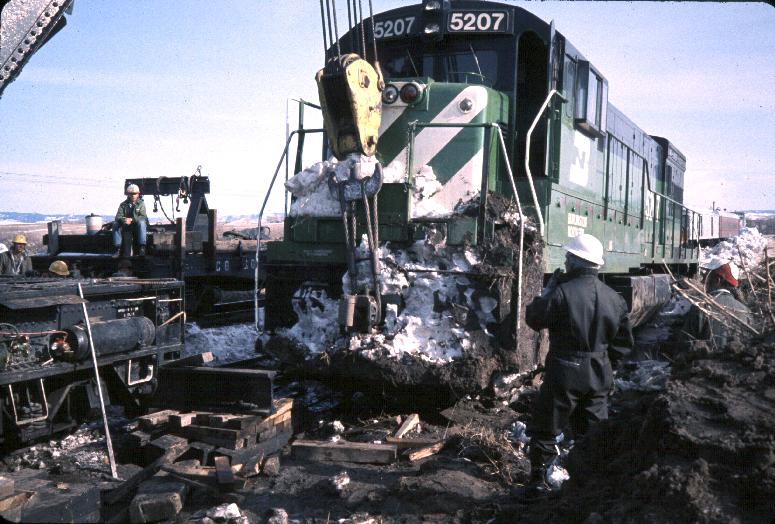
Crawford, Nebraska Wreck Train In March of 1975 I was working for BN out of Alliance, NE. A terrific late season blizzard struck completely closing all 4 routes out of Alliance. Rotaries, wedge plows, and Jordan Spreaders were operated to clear the lines. One track that did not get cleared right away was the Storage Track (a siding) just west of the C&NW "Cowboy Line" diamond at Crawford, NE. It lay buried under several feet of snow for perhaps 10 days to 2 weeks. The days after the blizzard were quite balmy with bright sunshine but the nights were well below freezing. This resulted in the snow alternately melting and refreezing, compacting it into almost solid ice at some places. Finally with the RR back to normal operations and the backlog cleared up a local frt was ordered to operate thru the Storage Track at Crawford to plow it out. The crew did as they were told. About half way thru the track they noticed something wasn't quite right and stopped. The three U23Cs had derailed on the packed snow and headed for the fence.I got called for the wreck train out of Alliance. At that time (1975) believe it or not the Big Hook was still steam! Trying to lift the locos it "chugged" real nice and real smoke and steam came out of the stack.
The 3rd unit was easy to rerail and took little time using oak blocks, wedges, and rerailing frogs. The west end of the 2nd unit was off the track a little ways but the east end was still over the rails. We pulled it back to where it was all on the ties then made short work of rerailing it. This photo is a view from the cab of the SD9 on the wreck train as we rerail the second unit.

The lead unit was going to be a different story. It was off to the side of the track, almost thru the right of way fence. The ground was not frozen before the blizzard so it was pure mud under the snow. The lead unit had plowed its way into a small embankment and had settled into the soft ground.

The bighook was positioned and the outriggers cribbed with ties and timbers. A cable sling was around the unit's drawbar and the hook had a firm grasp on the errant U23C. As the big hook began to chug the loco did not rise. Instead the derrick was pulled down sideways. The operator backed off the pull and the bighook righted herself. But the cribbing had been shoved down into the mud. More timber was placed between the top of the cribbing stacks and the outriggers. Again the lift was attempted...chuff, chuff, chuff, chuff, with the same results. Twice more this was attempted. Each time the cribbing was shoved further into the mud by the bighook's outriggers. Finally the cribbing reached firm ground (or bedrock!) and ceased its sinking. But the bighook still could not lift the beast! Further attempts simply tried to pull the wrecker over on its side. The mud had such a grasp on the loco that it acted like a giant suction cup holding the unit down.

A couple of hours of mud daubbing by hand shovels had much of the mud removed around and under the trucks and as much removed from under the fuel tank as could be reached. The bighook gave one more valiant try at freeing the loco from the quagmire. I remember the sound well. Hissing steam, roaring fire, then chuff, chuff, chuff, the cables tighten and the cribbing creaks. Chuff, chuff, chuG, chuG chuG, chug. There is a great sucking sound like a kid sucking the last drops of a milkshake thru a straw. The loco rises into the air, the wrecker rolls back vertical. There is applause all around.

It took a couple of lifts from both ends of the unit to get it back over the track and more mud had to be knocked from its underside. Eventually we got it rerailed.

The rerailing wasn't all of the story though. See the next page.



| Return to Tales index | My Home Page | E-Mail me |
Created 03-01-2002
Updated 03-02-2002